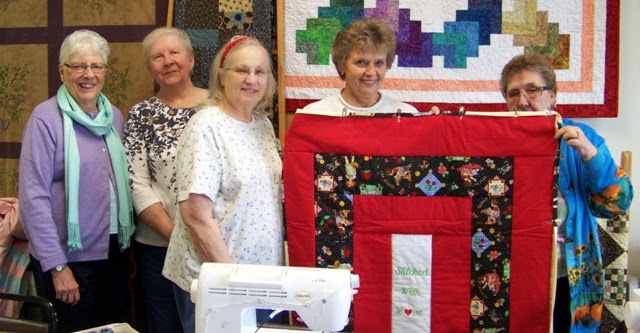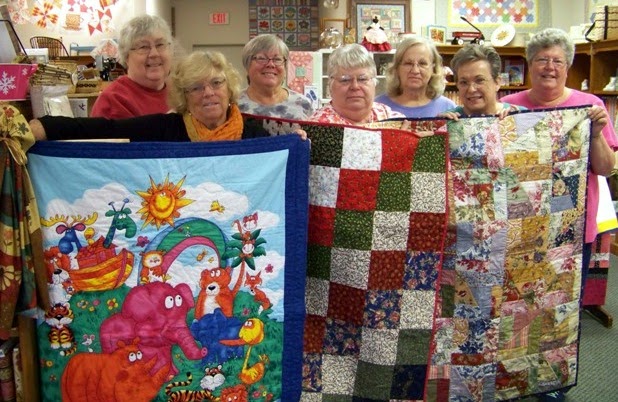
Protecting what matters to you most: your family, home, car, your
STASH.
What happens if there is a fire, flood, or you are away on vacation and someone breaks into your house and steals all your assets? Okay so not many thieves are going to steal your stash, but I bet if they think about it for a minute or two as they scan your sewing room and open a few closet doors, they will become aware of just how much money you have invested in your hobby and how valuable these things are. The big question is, do
you know how valuable your quilts, stash, and supplies are? Quilters are alike: buy when and what they can, add to their stash, and over the years have accumulated quite a number of $$$ in fabric and supplies. Some of you may even have vintage quilts or irreplaceable fabric you have picked up at estate sales or antique shops. Here is the ultimate question you should ask yourself:
HOW MUCH IS MY STASH WORTH? Can I get insurance? Is there a rider?
.
After checking with my insurance company, I learned that all such items are covered under “contents subject to deductible.” WHAT? I don’t even know what my deductible is. Furthermore, I would not begin to know how to make a claim. How could I prove or even estimate how much money is involved. What would the insurance company say when I told them that the fabric I purchased 10 years ago for $5 a yard was now worth $10 a yard? One insurance agent (not my own) in a rather snooty tone told me that “there is such a thing as depreciation, you know.” I wanted to tell him that fabric does not depreciate! Later, when I talked to my regular insurance agent I was told that there are five things quilters should do:
- Keep Good Records
When you start a quilt, document everything. Keep receipts of how much money you spend on fabric, pattern, batting, thread, and other supplies. Also record your time spent making the quilt. When the quilt is finished, take a picture of it and put it with the receipts. Document what awards this quilt receives. Keep this information together in a safe place. - List Your Supplies (below is just a sample and is by no means conclusive)
Spray starch
Sewing machines (I know one woman who has nine machines and says she uses them all depending on what project she is working on.)
Rotary cuter
Needles
Iron (I have several)
Cutting mats
Quilt batting
Pins
Threads
Design wall
Rotary cutters
Rulers
Books
Patterns
Magazines - Take Pictures
You have probably finished many quilts over the years. They decorate your home or are stored in your closets. Even if you do not have the receipts, you can still take a picture of them and put it in your records file. It’s proof that you had the quilts. - Get An Appraisal
Have you ever thought about what would happen if that beautiful quilt you loaned to the quilt shop, or have on display at the bank, or in a quilt show, was stolen or ruined in someway? How would you make a claim? Get an appraisal in writing and keep that with your other documentation. The Lost Quilt web page suggests that you have your quilt appraised every three years. - Get Your Finished Quilt Insured
We all tend to undervalue our own work. Quilts are valuable and you can have them insured. Get it in writing from your insurance agent that your quilt and the appraised value is on record should anything happen. Make sure you understand if the insurance covers the full value or the replacement value. Is it covered only while it is in your home, or if you have it on display elsewhere is it covered while there also? On the Lost Quilt web page you can find links to an insurance agent who offers a comprehensive policy that will insure your quilts, quilt making supplies, sewing machines, etc.
It sounds like a lot of work. I’d rather spend my time quilting than making a paper trail. If something happened, I could just go out and buy more fabric and that is half my fun in life. However, there are a couple of things to think about. It has taken me years to find these unique fabrics. Most important, who is going to pay for it? Not only have I accumulated a substantial amount of fabric, but what about my supplies and my machines. Sewing machines run into the thousands of dollars! So on second thought, maybe it is important to keep those records….just in case.
♥On a more positive note, Elins Kreative Side has the cutest free Redwork patterns. Check it out.
♥
Until Next Time, Happy Quilting,
Caroll

 You will notice two new buttons on my sidebar. Let me tell you about them. Margaret’s Hope Chest has agreed to provide a quilt for each child in the Grand Rapids, Michigan Public School system who is homeless during the Christmas season. Margaret's Hope Chest is looking for your help. The Hope Squared pattern is easy. Just make a quilt out of squares. Any size, any number, any color. Use up some scraps. Dig out your kid-themed fabrics and pair them with some bright solids. Please consider that all ages of children will be receiving these quilts-boys and girls. Base the size of your quilt on the size of the child you have in your mind as you create it. Please check out her blog and consider donating to this worthy cause. You may drop your quilts off or mail them to Margaret's Hope Chest, 630 Griswold SE, Grand Rapids, MI 49507.
You will notice two new buttons on my sidebar. Let me tell you about them. Margaret’s Hope Chest has agreed to provide a quilt for each child in the Grand Rapids, Michigan Public School system who is homeless during the Christmas season. Margaret's Hope Chest is looking for your help. The Hope Squared pattern is easy. Just make a quilt out of squares. Any size, any number, any color. Use up some scraps. Dig out your kid-themed fabrics and pair them with some bright solids. Please consider that all ages of children will be receiving these quilts-boys and girls. Base the size of your quilt on the size of the child you have in your mind as you create it. Please check out her blog and consider donating to this worthy cause. You may drop your quilts off or mail them to Margaret's Hope Chest, 630 Griswold SE, Grand Rapids, MI 49507. The other button is for the Blogger’s Quilt Festival. Whether you consider joining the fun and displaying a quilt or not, you will still want to click on the site and see all the beautiful quilts that will be on display. Seeing other’s creations is worth the visit and the amount of inspiration you will receive. Click on the button on the sidebar for further details. The Festival is being held from Oct. 9 – 16th. During that time the button will lead you to how you can sign up to display your quilts. If you have any questions, go to that site to see Amy’s updates.
The other button is for the Blogger’s Quilt Festival. Whether you consider joining the fun and displaying a quilt or not, you will still want to click on the site and see all the beautiful quilts that will be on display. Seeing other’s creations is worth the visit and the amount of inspiration you will receive. Click on the button on the sidebar for further details. The Festival is being held from Oct. 9 – 16th. During that time the button will lead you to how you can sign up to display your quilts. If you have any questions, go to that site to see Amy’s updates.




























 The following directions are for the baggy socks only. This picture is to show you that the fabric for the legs needs to be longer than the template to allow extra material for scrunching.
The following directions are for the baggy socks only. This picture is to show you that the fabric for the legs needs to be longer than the template to allow extra material for scrunching.



























